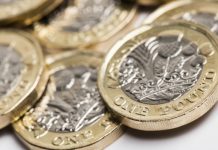- Pound (GBP) is under pressure amid fears of a second coronavirus wave
- Consumer demand on the high street is picking up with retailers less inclined to slash prices
- US Dollar (USD) holds steady ahead of Federal Reserve rate decision
- No change to policy is expected and Congress has not agreed a stimulus deal
The Pound US Dollar (GBP/USD) exchange rate is edging lower snapping an 8 session winning streak. The pair has surged from a low of US$1.2510 to a high of US$1.2938 since 17th July. At 06:15 UTC, GBP/USD trades -0.1% at US$1.2917.
Coronavirus cases in the UK are rising quickly with Boris Johnson warning of a second wave within the next two weeks. Rises were recorded each day last week for the first time since the April peak. The seven-day average stands at 700, this is up 28% on three weeks ago. Government officials are now extremely concerned that a second wave could hit before this winter.
Covid and Brexit concerns overshadowed data which showed consumer demand was returning. According to the British Retail Consortium, British retailers discounted their goods by less in July than in the previous months as consumer demand picked up amid the easing of lockdown restrictions.
The BRC reported that average shop prices in July were just 1.3% lower than the same month the previous year. This is an improvement on 1.6% lower in June and 2.4% lower in May. Higher shop prices indicate that consumers are willing to pay more and should boost inflation.
The US Dollar traded flat across the board heading towards the European open amid fears that the US is losing control of the coronavirus outbreak dashing hopes a quick economic recovery.
Florida reported a record number of daily cases whilst Texas hit a grim 400,000 cases milestone, adding pressure on Congress to pass another huge stimulus package. However, talks have stalled with no agreement in sight
The US Federal Reserve will give its monetary policy decision today. No changes are expected from the Fed. Since the last meeting economic data has been broadly improving and had the number of coronavirus cases stabilized or declined then the Fed could have talked about an improving recovery.
However, unfortunately that is not the case and the two biggest threats to the US economy – the rising covid cases and the government’s fiscal response – the Fed has no control over. The picture has deteriorated and expectations are for Fed dovishness to continue.





